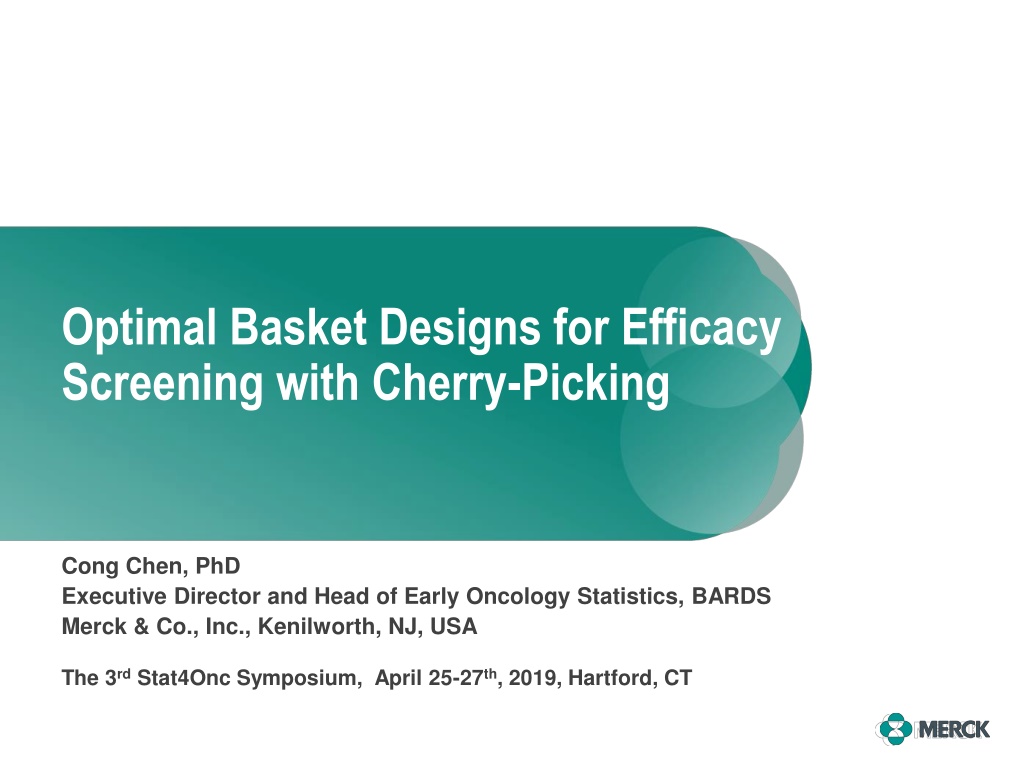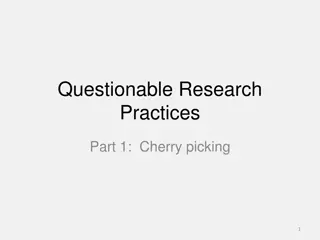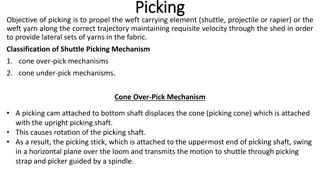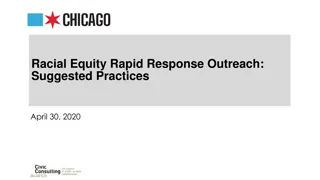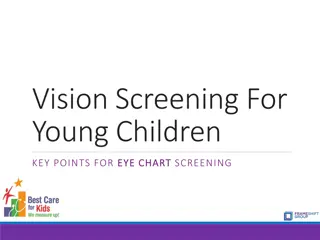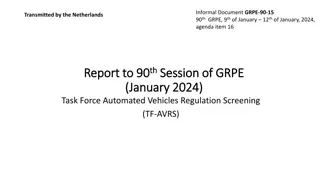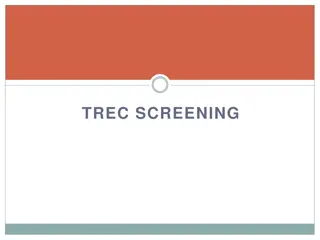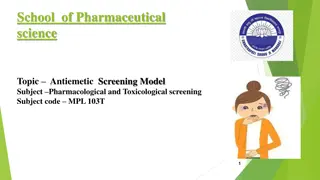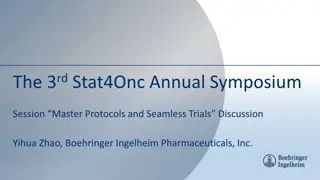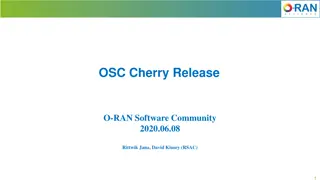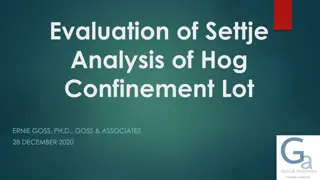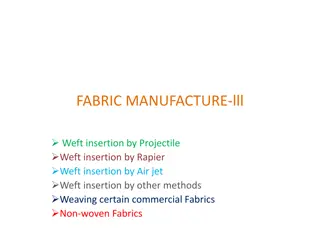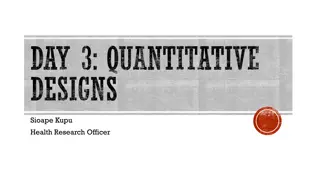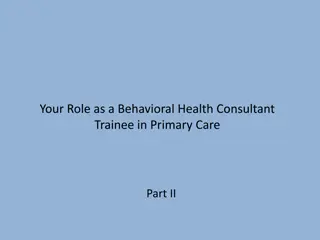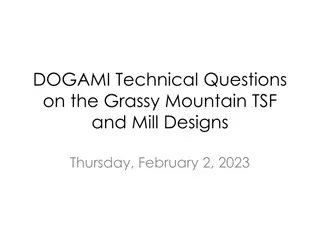Optimal Basket Designs for Efficacy Screening with Cherry-Picking
Efficacy screening in oncology trials involves evaluating multiple tumor types simultaneously to enhance drug development efficiency. Basket trials minimize missed opportunities but risk cherry-picking for positive results. Statistical methods, like multiplicity control and Bayesian information borrowing, aim to address these challenges. Understanding the benefits and complexities of cherry-picking is crucial for optimal design and interpretation of clinical trials in oncology.
Download Presentation

Please find below an Image/Link to download the presentation.
The content on the website is provided AS IS for your information and personal use only. It may not be sold, licensed, or shared on other websites without obtaining consent from the author. Download presentation by click this link. If you encounter any issues during the download, it is possible that the publisher has removed the file from their server.
E N D
Presentation Transcript
Optimal Basket Designs for Efficacy Screening with Cherry-Picking Cong Chen, PhD Executive Director and Head of Early Oncology Statistics, BARDS Merck & Co., Inc., Kenilworth, NJ, USA The 3rd Stat4Onc Symposium, April 25-27th, 2019, Hartford, CT
Explosive Oncology Trials Science, March 23, 2018 2
Efficacy Screening Benefit of finding an active new drug quickly and cost- effectively outweighs the risk of wrong tumor selection A set of tumor types are often investigated simultaneously in a basket trial to account for Type III error of missed opportunities 3-5 shots on goal Chen C, Deng Q, He L, Mehrotra D, Rubin EH, Beckman RA. How many tumor indications should be initially studied in clinical development of next generation immunotherapies? Contemporary Clinical Trials 2017; 59:113-117. 3
Hypothetical Outcome of a Simple Basket Trial Five tumor cohorts (n=25 each) in patients refractory to PD-1 treatment (ORR under null: 10%) Number of responses range from 2 (8%) to 6 (24%) 6 5 4 3 ORR under null: 10% 2 4
Independent Evaluation Each tumor cohort is evaluated separately, with or without multiplicity adjustment 6 ? 5 X 4 X P=0.033 P=0.098 3 X P=0.24 ORR under null: 10% 2 X 5
Ad-hoc Assessment Clinical director 1: Look at the 3 top ones! The drug is working!! Clinical director 2: This is cherry-picking. 6 5 4 3 ORR under null: 10% 2 6
Bayesian Information Borrowing Expert statisticians all assume some form of homogeneity on response rates across tumor cohorts Thall et al. 2003, Berry et al. 2013, Simon et al., 2016, Cunanan et al., 2017 Clinical director 1: I like Bayesian, but why does response to an active drug have to be homogeneous? Clinical director 2: It is too complicated for me. Can t you just tell me how to cherry-pick properly? 7
Multiplicity Control for Cherry-picking Chen C, Li N, Yuan S, Antonijevic Z, Kalamegham R, Beckman RA. Statistical considerations of a Phase 3 basket trial for simultaneous investigation of multiple tumor types in one study. Statistics in Biopharmaceutical Research 2016; 8 (3): 248-257. design and Zhou H, Liu F, Wu C, Rubin EH, Giranda VL, Chen C. Optimal Two-stage Designs for Exploratory Basket Trials, submitted. Wu C, Liu F, Zhou H, Rubin EH, Giranda VL, Chen C. Optimal Design and Analysis of Efficacy Expansion in Phase I Oncology Trials, to be submitted. Chen C, Zhou H, Li W, Beckman RA. How Many Substudies Should be Included in a Master Protocol? to be submitted. 8
Basket Designs with Cherry-picking Prune inactive ones and pool active ones in the pooled analysis (pruning and pooling) Type I error is controlled at target level under global null Type II error is calculated under a non-informative prior for number of active tumors (i.e., uniform distribution) Design parameters can be obtained similarly when an informative prior is available Don t rely on homogeneous assumption for analysis 9
Fit-for-purpose Fix power or sample size? One or two- stage? Same or different hypotheses? 10
A One-stage Design Example with Same Null/Alternative Hypotheses Design of a 5-tumor basket trial with minimal sample size targeting ( , )=(0.05, 0.20) P0 0.10 P1 0.25 r 4 * 0.009 n 25 The sample size in the hypothetical trial is optimal The clinical intuition of pooling tumors with 4 responses makes sense The pooled data should be tested at *=0.009 11
Positive Outcomes in the Hypothetical Trial The drug is deemed active based on hypothetical outcome (4+5+6=15 responses in 3 tumor cohorts) However, it doesn t mean all 3 tumor cohorts are active # Tumors 1 2 3 4 5 Sample size Min #resp 25 50 75 100 125 Min ORR 32% 24% 20% 19% 18% 8 12 15 19 22 12
A One-stage Design Example with Heterogenous Null/Alternative Hypotheses Set-up for (H0, H1) Mono in 3 tumor cohorts without SOC: (0.05, 0.2) Combo with SOC in 2 tumor cohorts: (0.2, 0.35) Design features Each has comparable probability to be pooled Minimum overall sample size to achieve the desired Type I/II error rates Overall response rate in the pool is compared to H0 for the pooled tumor cohorts weighted by sample size 13
Design of the Hypothetical Trial Design parameters at ( , )=(0.05, 0.20) Total sample size=3*18+2*34=122 P0 0.05 0.2 P1 0.2 0.35 r 2 9 n 18 34 * 0.011 Probability of pooling (23%, 23%) under P0 for (mono, combo) (90%, 89%) under P1 for (mono, combo) 14
Examples of A Positive Outcome Assuming there is one mono and one combo left in the pool (n=52=18+34) #resp(%) to mono 2 (11%) 4 (22%) 6 (33%) #resp(%) to combo 13 (38%) 11 (32%) 9 (26%) Overall #resp(%) Weighted ORR (H0) P-value 15 (29%) 14.8% 0.0069 15
Two-stage Optimal Basket Designs Design parameters of a two-stage 5-tumor basket trial with minimal sample size for same (P0, P1)=(0.1, 0.25) targeting ( , )=(0.05, 0.20) An extension of Simon s two-stage designs for single arm trials to a multi-arm basket trials N=43/40 under Simon s designs for single arm trials r1 2 3 n1 9 18 * 0.019 0.009 n 33 25 Optimal Minimax Tumor cohorts with r1/n1 responders will be pooled for analysis at end of second stage 16
Two-stage Design Under Fixed Sample Size Remaining sample size for early-terminated tumor cohorts is evenly distributed to the continuing ones Design parameters of a two-stage 5-tumor basket trial with minimal sample size for same (P0, P1) & ( , ) Planned sample size per arm (n=20) is smaller than under the optimal design (n=33) However, may have more patients in a remaining arm (e.g., n=35 if 3 arms were terminated in first stage) r1 2 n1 10 * 0.018 n 20 17
Comments The basket designs based on pruning and pooling provide closed-form sample size estimates for planning purpose Rejection of the global null means drug is active which paves the way for further investigation RWE may be used to assist with GNG decisions in this dynamic era post immunotherapy revolution Alternative endpoint to ORR and randomized controlled designs may be considered as appropriate Various extensions under investigation (e.g., two-stage under heterogeneous hypotheses) 18
